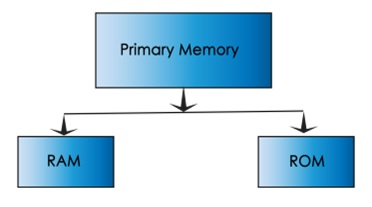
- Computer Concepts Tutorial
- Computer Concepts - Home
- Introduction to Computer
- Introduction to GUI based OS
- Elements of Word Processing
- Spread Sheet
- Introduction to Internet, WWW, Browsers
- Communication & Collaboration
- Application of Presentations
- Application of Digital Financial Services
- Computer Concepts Resources
- Computer Concepts - Quick Guide
- Computer Concepts - Useful Resources
- Computer Concepts - Discussion
Computer Concepts - Computer Memory
Computer memory refers to storage area where data is stored. It is of two types −
- Primary Memory
- Secondary Memory
Primary Memory
Primary memory is the main memory of computer present in motherboard. Primary memory is of two types as shown in the image below.

Random Access Memory
RAM is referred as temporary memory, in which, information stored is lost once computer is turned off. It is a volatile memory. Instructions written in this memory can be modified; hence it is also known as programmable memory. The two types of RAM are Static RAM (faster and costlier) and Dynamic RAM.

Functions of RAM are as follows −
It stores data till it gets processed.
It stores instructions for data processing.
It acts as a working space where data processing takes place and intermediate results are stored.
It stores processed data/results before it is sent to output devices.
Read Only Memory
ROM is referred as permanent memory, in which information stored is available even if computer is turned off. Instructions stored in this memory can only be read and cannot be modified. Mostly ROM has a start-up instruction which is executed every time when computer is switched on. Types of ROM are PROM (Programmable Read Only Memory), EPROM (Erasable PROM), EEPROM (Electrically Erasable PROM) and flash memory.

The below table jots down the major differences between RAM and ROM −
| Sr.No | RAM | ROM |
|---|---|---|
| 1 | It is volatile memory. | It is non-volatile memory. |
| 2 | The contents are temporary; data is lost when electricity supply is lost. | The contents are permanent; data is not lost even when power is switched off. |
| 3 | Available in small storage capacity. | Available in high storage capacity. |
| 4 | Processing speed is high. | Processing speed is low. |
| 5 | User-defined programs can be stored. | Generally, operating system supporting programs can be stored. |
| 6 | Cost is very high. | Cost effective. |
| 7 | It is of two types, SRAM and DRAM. | It comes in different types such as PROM, EPROM, EEPROM and flash memory. |
Secondary Memory
Sometimes when data to be processed is large, it cannot fit in primary memory as it is limited, in such cases, we use supplement memory or secondary memory. Secondary memory helps to store information permanently and is non-volatile. Examples of secondary storage memory are compact disk, floppy disk, pen drive, external hard drive, etc.